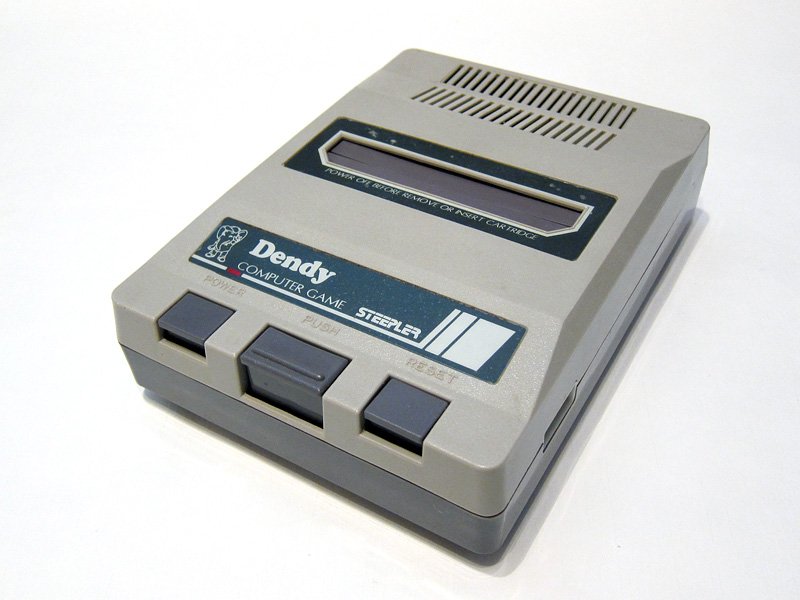-
1992
Hardware Description
Dendy (Russian: Де́нди) is a Taiwanese hardware clone of the Family Computer (the Japanese version of the Nintendo Entertainment System), produced for the Russian market. It was released in 1992 by the Steepler company. The Dendy was easily the most popular video game console of its time in the former USSR region and enjoyed a degree of fame roughly equivalent to that experienced by the NES/Famicom in North America, Japan and Western Europe. In 1992, Dendy was selling in the Russian Federation for 39,000 rubles (roughly 70–80 USD); by 1994, over one million Dendy units were sold in Russia, and the price was roughly $35.
Victor Savyuk (Russian: Виктор Савюк) first heard about Nintendo in 1991 when it was enjoying great commercial success with the NES console in Japan and the Western world. Hoping to repeat this success in Russia in the period immediately following the collapse of the USSR, Savyuk began importing counterfeit consoles from Asia to Russia. Although it was already possible to buy Famicom clones and NES consoles from local distributors, Savyuk began making plans to invent, register and promote his own brand. Seeking a company in Moscow that would be able to manage sales and distribution locally, in 1992 he stumbled upon Steepler (Russian: Стиплер) which agreed to manage this aspect of the business. The new console would be called the Dendy (Russian: Денди) and its logo was created by Ivan Maximov.
The Dendy first appeared on the market in December 1992, selling at the price of 39,000 rubles (equivalent to US$173 in 2019). Marketing for the console led to a series of animated television advertisements with the phrase "Dendy, Dendy! We all love Dendy! Dendy – everyone plays!" Later, a TV show was launched called "Dendy - The New Reality". By April 1993, Steepler had four regional distributors and had generated 500 million rubles in revenue (equivalent to US$1.3 million in 2019).
For a while, the Dendy's main competitors were similar products from China. It was not until November 1993 that a competitors, the Sega consoles imported by Nisho Iwai and distributed by Forrus, were introduced to the market. Steepler reorganized in early 1994, resulting in the separation and creation of the Lamport company, which later manufactured the Kenga, another Famicom Clone. By mid-1994, Steepler had already sold 1 million Dendy consoles and was selling between 100,000 and 125,000 more per month with a revenue of $5 million. At this time, the price of the consoles had dropped to roughly $30–$35.
In August 1994, Incombank and Steepler announced plans to start up a joint business venture called Dendy, in which Incombank would contribute capital and receive 30% of profits. At the end of 1994, two more Dendy rivals (also NES clones) appeared: the Kenga, manufactured by Lamport, and the Bitman, distributed by R-Style and Subor (Russian: Сюбор). In November 1994, the newly created Dendy company signed an agreement with Nintendo, in which they were forbidden from promoting Sega products and given exclusive distribution rights to the SNES in Russia. There was a clause in the contract, that Nintendo had no claims against the Dendy console and therefore Steepler could continue to trade them. Due to many problems Steepler collapsed in 1996. The subsidiary AOZT Dendy continued to sell the consoles until 1998, when they ceased operations.
Modern Dendy consoles, which can still be found alongside Chinese products in many markets, are manufactured in China and have no relation to the Steepler company. They are also lower quality clones using NOAC SoCs which suffer from various issues, the most common one being no expansion audio (something the Dendy Jr suffered from). Many also have the 25% and 50% pulse waves swapped. Dendy consoles had cloned but otherwise separate CPU and PPU.
-
Manufacturer:
-
Hardware Type:
Video Game -
Manufacture Year:
1992 -
More Info:
-
We recognize our sponsors starting at $1 per entry.
Learn more at https://www.ithistory.org/benefits
Date discontinued:
1998

